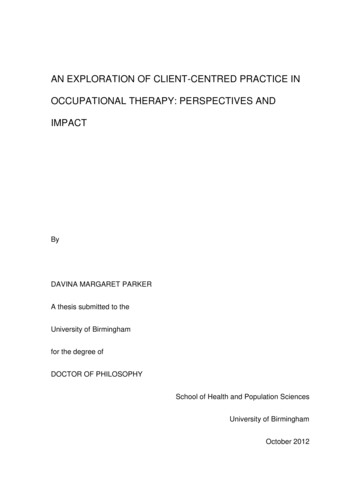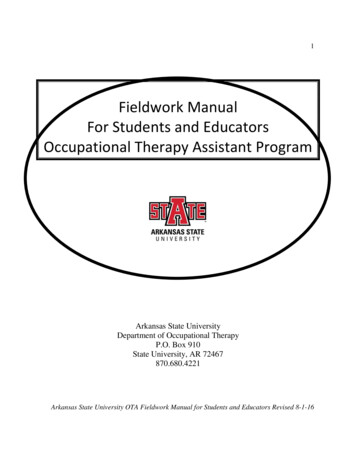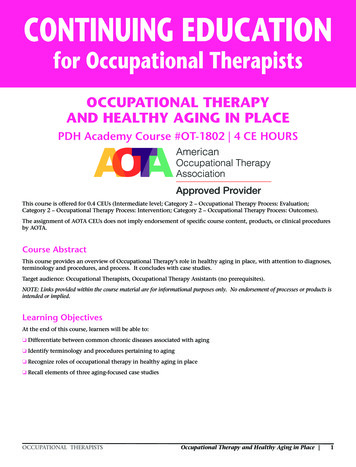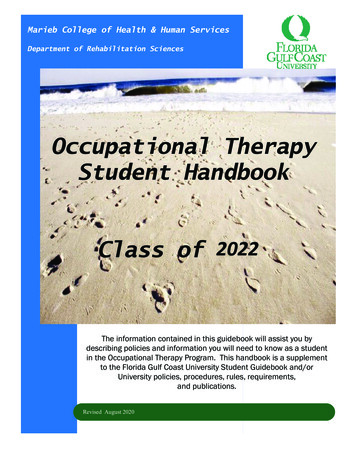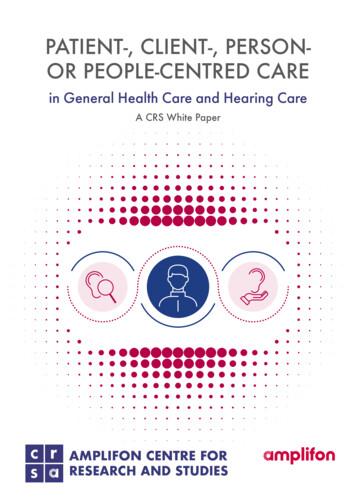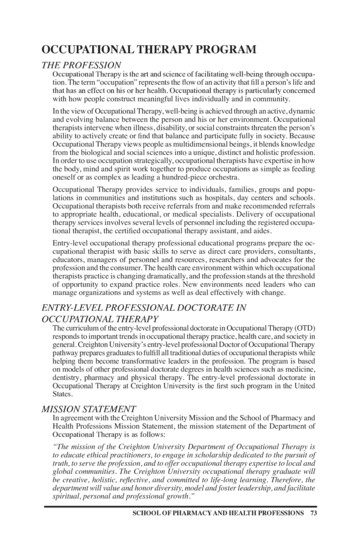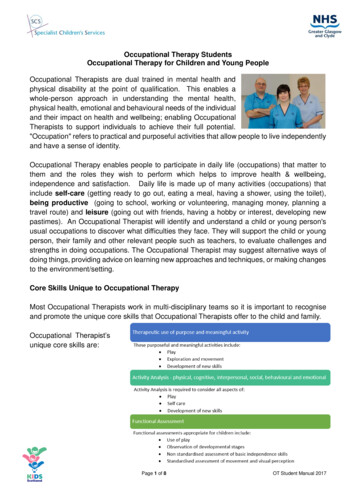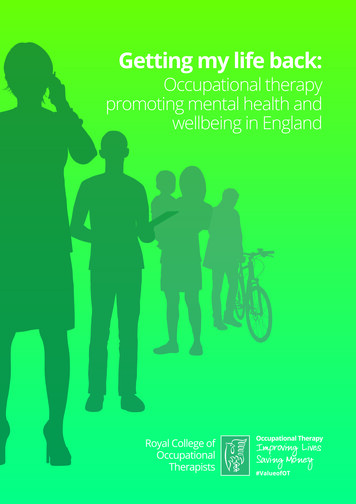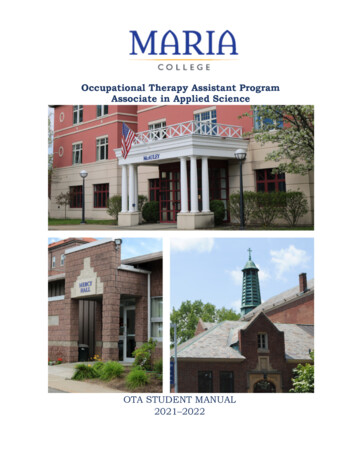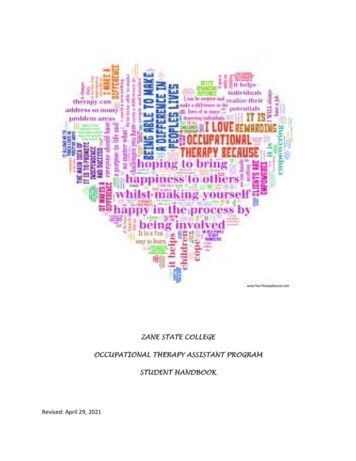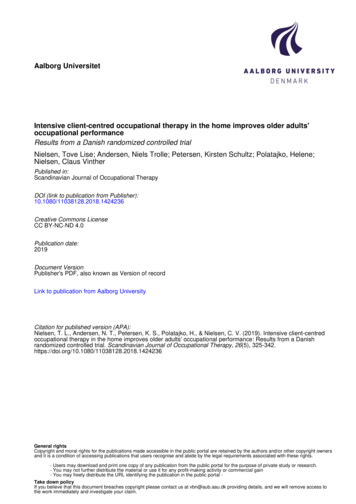
Transcription
Aalborg UniversitetIntensive client-centred occupational therapy in the home improves older adults'occupational performanceResults from a Danish randomized controlled trialNielsen, Tove Lise; Andersen, Niels Trolle; Petersen, Kirsten Schultz; Polatajko, Helene;Nielsen, Claus VintherPublished in:Scandinavian Journal of Occupational TherapyDOI (link to publication from Publisher):10.1080/11038128.2018.1424236Creative Commons LicenseCC BY-NC-ND 4.0Publication date:2019Document VersionPublisher's PDF, also known as Version of recordLink to publication from Aalborg UniversityCitation for published version (APA):Nielsen, T. L., Andersen, N. T., Petersen, K. S., Polatajko, H., & Nielsen, C. V. (2019). Intensive client-centredoccupational therapy in the home improves older adults' occupational performance: Results from a Danishrandomized controlled trial. Scandinavian Journal of Occupational Therapy, 26(5), 236General rightsCopyright and moral rights for the publications made accessible in the public portal are retained by the authors and/or other copyright ownersand it is a condition of accessing publications that users recognise and abide by the legal requirements associated with these rights.- Users may download and print one copy of any publication from the public portal for the purpose of private study or research.- You may not further distribute the material or use it for any profit-making activity or commercial gain- You may freely distribute the URL identifying the publication in the public portal Take down policyIf you believe that this document breaches copyright please contact us at vbn@aub.aau.dk providing details, and we will remove access tothe work immediately and investigate your claim.
Scandinavian Journal of Occupational TherapyISSN: 1103-8128 (Print) 1651-2014 (Online) Journal homepage: http://www.tandfonline.com/loi/iocc20Intensive client-centred occupational therapy inthe home improves older adults’ occupationalperformance. Results from a Danish randomizedcontrolled trialTove Lise Nielsen, Niels Trolle Andersen, Kirsten Schultz Petersen, HelenePolatajko & Claus Vinther NielsenTo cite this article: Tove Lise Nielsen, Niels Trolle Andersen, Kirsten Schultz Petersen, HelenePolatajko & Claus Vinther Nielsen (2018): Intensive client-centred occupational therapy in the homeimproves older adults’ occupational performance. Results from a Danish randomized controlledtrial, Scandinavian Journal of Occupational Therapy, DOI: 10.1080/11038128.2018.1424236To link to this article: https://doi.org/10.1080/11038128.2018.1424236 2018 The Author(s). Published by InformaUK Limited, trading as Taylor & FrancisGroupPublished online: 12 Jan 2018.Submit your article to this journalArticle views: 154View related articlesView Crossmark dataFull Terms & Conditions of access and use can be found tion?journalCode iocc20Download by: [Aalborg University Library]Date: 15 January 2018, At: 04:08
SCANDINAVIAN JOURNAL OF OCCUPATIONAL THERAPY, RIGINAL ARTICLEIntensive client-centred occupational therapy in the home improves olderadults’ occupational performance. Results from a Danish randomizedcontrolled trialTove Lise Nielsena,b,c , Niels Trolle Andersend, Kirsten Schultz Petersene, Helene PolatajkofClaus Vinther Nielsena,candaSection for Clinical Social Medicine and Rehabilitation, Department of Public Health, Aarhus University, Aarhus, Denmark;Department of Occupational Therapy, VIA University College, Aarhus, Denmark; cDEFACTUM Central Denmark Region, Aarhus,Denmark; dSection for Biostatistics, Department of Public Health, Aarhus University, Aarhus, Denmark; eDepartment of Health Scienceand Technology, The Faculty of Medicine, Public Health and Epidemiology Group, Aalborg University, Aalborg, Denmark; fDepartmentof Occupational Science and Occupational Therapy, and Rehabilitation Sciences Institute, University of Toronto, Toronto, ON, CanadaDownloaded by [Aalborg University Library] at 04:08 15 January 2018bABSTRACTARTICLE HISTORYBackground: There is growing interest in enabling older adults’ occupational performance. Wetested whether 11 weeks of intensive client-centred occupational therapy (ICC-OT) was superiorto usual practice in improving the occupational performance of home-dwelling older adults.Methods: An assessor-masked randomized controlled trial among adults 60 þ with chronichealth issues, who received or applied for homecare services. Recruitment took place September2012 to April 2014. All participants received practical and personal assistance and meal deliveryas needed. In addition, they were randomized to receive either a maximum 22 sessions of occupation-based ICC-OT (N ¼ 59) or to receive usual practice with a maximum three sessions ofoccupational therapy (N ¼ 60). The primary outcome was self-rated occupational performanceassessed with the Canadian Occupational Performance Measure (COPM).Results: No important adverse events occurred. ICC-OT was accepted by 46 participants (88%),usual practice by 60 (100%). After 3 months, the ICC-OT-group had improved 1.86 points onCOPM performance; the Usual-Practice group had improved 0.61 points. The between-group difference was statistically significant (95% confidence interval 0.50 to 2.02), t-test: p ¼ 0.001.Conclusions: ICC-OT improved older adults’ occupational performance more effectively thanusual practice. This result may benefit older adults and support programmatic changes.Received 9 June 2017Revised 20 December 2017Accepted 2 January 2018IntroductionIn Denmark, as in many other countries, promotingolder adults’ ageing in place is a major aim supportedby policy makers and service providers, who anticipatedramatic increases in welfare costs due to ongoingdemographic changes [1–3]. In addition, there is growing interest in transferring some of the traditional passive services for older adults to rehabilitation, in anattempt to maintain older adults’ functional ability andto enable their occupational performance and wellbeing[1–3]. In Denmark, most older adults live alone or witha spouse; 33% of 65–79 year-olds and 66% of 80þ yearolds live alone [4]. Danish elder care, includingrehabilitation, is a universal service; the responsibilitylies at the local level in the municipalities, and all olderadults have access free of charge, when certain criteriaCONTACT Tove Lise NielsenKEYWORDSClient-centred; home;occupation-based; occupational therapy; occupationalperformance; older adultsare met [3]. A Danish national report sums up possibilities and challenges regarding older adults’ participationin rehabilitation [5]. The report is informed by a number of evaluations based on interviews with older adults.To be able to reestablish one’s previous level of functioning was a general aim and motivational factoramong the participants of the evaluations. The samepertained to a wish to live independently, especiallymanaging one’s personal care alone. The wish to beindependent with regard to housekeeping was lessstrong. Indeed, older adults who felt lonely were generally less interested in becoming independent, as theyfeared they would be deprived of their homecare assistants [5].Occupational therapy (OT) is a valued and wellintegrated profession within rehabilitation for olderton@via.dkß 2018 The Author(s). Published by Informa UK Limited, trading as Taylor & Francis GroupThis is an Open Access article distributed under the terms of the Creative Commons Attribution-NonCommercial-NoDerivatives License ), which permits non-commercial re-use, distribution, and reproduction in any medium, provided the original work is properly cited, and is not altered, transformed, or built upon in any way.
Downloaded by [Aalborg University Library] at 04:08 15 January 20182T. L. NIELSEN ET AL.adults [6–9]. In the rehabilitation context of Danishmunicipalities, home-based OT is typically deliveredto older adults in one of two ways: (1) As a comprehensive client-centred OT intervention building onthe older adults’ own goals and planned and deliveredby occupational therapists through the full period ofrehabilitation, in some cases as part of a multidisciplinary approach [10,11], or (2) As an element ofhomecare re-ablement where occupational therapistswork as consultants to the homecare personnel [10].The core of OT is to enable clients’ occupationalperformance and wellbeing [12,13]. Occupational performance may be improved through occupation-basedOT where occupation acts as both means and end.Typically, acquisitional, adaptive and restorative intervention models are used, and the occupations, whichthe older adults want or need to do, are addressed ina client-centred process [13–16]. Client-centred practice within OT is defined by the Canadian approaches aimed at enabling occupation with clients[17]. It is stressed that in client-centred practice:Occupational therapists demonstrate respect for clients,involve clients in decision-making, advocate with andfor clients in meeting clients’ needs, and otherwiserecognize clients’ experience and knowledge [17].Client-centred OT is generally valued and practisedwithin Danish OT, and the Canadian OccupationalPerformance Measure (COPM), which supports thispractice, is widely used in Danish municipalities [18].Client-centredness holds a high priority in Danish OTcurricula, informed by Canadian and US conceptualand practice models and outcome measures[13,14,17,19,20]. Gupta and Taff [21] have argued thatclient-centred practice is best embodied by occupation-focused interventions in the natural environmentof everyday living. This supports the provision of OTin and around the client’s home. Challenges in clientcentred practice have been identified at the level ofthe healthcare system [22]. In Denmark, homecare reablement for older adults is becoming increasinglywide spread [23]. A client-centred approach to homecare re-ablement is supported by law through the consolidating act on social services, which emphasizescooperation with the client and building on the client’sindividual goals [10]. Nevertheless, at the time the present study was carried out, Danish occupationaltherapists’ client-centred values and practices werechallenged. Local policies in many Danish municipalities downplayed individual goal-setting by limiting thefocus of homecare re-ablement to the performance oftasks and activities for which the older adults wouldotherwise be eligible to receive help. The aim was tosave municipal homecare costs. In addition, theamount of OT within homecare re-ablement was insome municipalities limited to a few visits or no OT atall, and the re-ablement was mainly carried out byhomecare assistants. This situation is what we refer toas ‘usual practice’ (as opposed to client-centred) in thepresent study.Occupational therapists are obliged to work in anevidence-based manner [24]. Yet there is a paucity ofquality intervention literature, and client-centred andhome-based OT for older adults has not previouslybeen tested in a Danish context. A recent systematicliterature review identified only a small number ofhigh-quality studies concerning home-based and occupation-based OT [25]. The studies were predominantlyEuropean and North American, and the interventionswere with older adults post stroke, with Parkinson’sdisease, or with various chronic health issues [25].While OT was found to effectively improve occupational performance within the domains of self-care,productivity, and client-identified occupations [26–31],small effect sizes were reported in several studies[26,27,31], and there were problems with maintainingthe achieved improvements after discharge [27,29].The amount of OT in the studies ranged from two tonine sessions [25]. However, the authors did not examine the relationship between amount and outcome.Previous studies have shown that a larger amount ofOT and physiotherapy could improve clients’ outcomesin inpatient settings, and that the amount of OT wasfrequently far too small to be effective [32–34]. Thereis therefore a need to test the effect of in-home interventions that are more intensive than those reported inthe above-mentioned literature review. Furthermore,many older adults who receive home-based services areaffected by a range of chronic and often concurrenthealth issues and have very different needs.Accordingly, it is important to examine the effectiveness, over time, of intensive, client-centred occupationand home-based OT targeting diverse populations.Objectives and hypothesesThe objective of this study was to compare 11 weeksof occupation-based intensive client-centred OT (ICCOT) in the homes of older adults to the usual practicein one Danish municipality. One primary hypothesiswas formulated:Primary hypothesis: ICC-OT will be superior tousual practice in improving the participants’ self-rated
Downloaded by [Aalborg University Library] at 04:08 15 January 2018SCANDINAVIAN JOURNAL OF OCCUPATIONAL THERAPYoccupational performance, measured as the changebetween the assessments at baseline and 3 monthspost baseline.Secondary hypotheses were formulated, building onour expectations that the ICC-OT would outperformusual practice on three counts: participants’ would bemore satisfied with the occupational performance(Secondary hypothesis 1); the observed quality of occupational performance would be higher (motor abilitiesand process abilities, Secondary hypothesis 2 and 3);and health-related quality of life would be increased(physical components and mental components,Secondary hypothesis 4 and 5), measured as thechanges in these variables between the assessments atbaseline and 3 months post baseline.Finally, we expected that the improvements oneach of the six above-mentioned outcomes would bemaintained 6 months later, i.e. compared with baseline, the ICC-OT group would fare better than theUsual-Practice group (Secondary hypothesis 6 to 11).(Table 3 refers to the numbered hypotheses).MethodsA randomized controlled parallel group superioritytrial was performed with an allocation ratio of 1:1 toICC-OT or usual practice, and assessor-maskedassessments at baseline, and at 3 and at 6 months,post-baseline.Setting and standard servicesThe study took place in The Municipality of Randers(Randers Kommune), a Danish municipality of 97,500inhabitants, of which 25% were 60þ years old [35].Personal care, practical help, meal delivery, OT,homecare re-ablement, physiotherapy, assistive devicesand minor home modifications were the responsibilityof a municipal homecare office. The services wereoffered free of charge to home-dwelling older adultswith functional limitations when specified requirements were met [10]. Participants in both studygroups were eligible for these standard services. Theonly differences in services pertained to OT andhomecare re-ablement.Table 1 presents details concerning the rehabilitative services received in the trial period. Within thefirst 3 months, more participants in the ICC-OTgroup than in the Usual-Practice group receivedassistive devices and minor home modifications (24vs. nine), chi-square test: p ¼ 0.002.ParticipantsIncluded in the study were older men and womenaged 60þ. They experienced occupational performance problems and were therefore applying for, oralready receiving, homecare services. They lived inprivate homes or in sheltered housing and were ableto communicate in Danish. Excluded were olderadults with physician-ascertained alcohol or drugabuse, tetraplegia, dementia, severe mental illness orsevere intellectual disability. Also excluded were olderadults who had severe pain and/or rapidly progressivediseases such as cancer or motor neuron disease.These criteria assured that participants in the studywere similar to those who would usually be considered for rehabilitation. Further exclusion criteria were:having a rehabilitation plan from a hospital, previousparticipation in homecare re-ablement, or living witha participant of the present study.Enrolment and randomizationA homecare officer at a central municipal officeinvited older adults to participate in the study whenthe older adults applied for homecare for the firsttime or were about to have their needs reevaluated.Table 1. Details concerning the received rehabilitative services in the trial period.ICC-OT groupn ¼ 59 at baseline, n ¼ 46 at 3 monthsICC-OT from baseline to 3 monthsOT delivered as part of usual practice frombaseline to 3 monthsPhysiotherapy from baseline to 3 monthsADsa from baseline to 3 monthsOT delivered as part of usual practice from 3months to 6 monthsPhysiotherapy from 3 months to 6 monthsADsa from 3 months to 6 monthsa3Usual-Practice groupn ¼ 60 at baseline, n ¼ 53 at 3 months52 participants had, on average, a total of11 hours over 15 sessions9 participants had, on average, a total of5.4 hours24 participants had 39 ADs in all3 participants had, on average, a total of0.8 hours12 participants had, on average, a total of5.4 hours8 participants had 16 ADs in allAssistive devices and minor home modifications. ICC-OT: Intensive Client-Centred Occupational Therapy.14 participants had, on average, a total of3.1 hours5 participants had, on average, a total of6.6 hours9 participants had 15 ADs in all3 participants had, on average, a total of3.6 hours6 participants had, on average, a total of7 hours10 participants had 15 ADs in all
Downloaded by [Aalborg University Library] at 04:08 15 January 20184T. L. NIELSEN ET AL.Initial information was given by means of a standardized telephone-protocol. Research occupationaltherapists visited the older adults, checked eligibilitycriteria and gave oral and written information.Willing participants gave written informed consentand went through the baseline assessments. Finally, ahomecare officer assigned the participants to the ICCOT or usual practice arm of the study. The officer followed a computerized randomization procedure generated by a data management team. Blockrandomization produced balanced study arms. Theblock sizes and the random allocation sequence wereconcealed until all participants were assigned to theirgroups. Recruitment took place from 1 September2012 to 30 April 2014. The last follow-up was performed 31 October 2014.Intensive client-centred occupational therapy (ICCOT)Figure 1 depicts the characteristics of the ICC-OTintervention performed by the research occupationaltherapist. The ICC-OT took place in and around theparticipants’ homes and in other environments of thelocal community, as appropriate given the participants’ performance issues and goals. One researchoccupational therapist was assigned to each participant. Key points in the ICC-OT that reflected theclient-centred approach [13,19] included respectingthe older adults’ individual life styles; seeking, respecting and addressing their priorities and choices concerning the focus of the OT intervention; workingcollaboratively on goal-setting and during the intervention; and assessing the older adult’s performancewith an individualized client-centred outcomes measure before and after the intervention. It was possibleto change the original goals and to work on new/additional goals if such should evolve during the process.The protocol (see Figure 1) specified up to 11weeks of ICC-OT (Week 2 to 12) with two sessionsper week and a maximum of 22 sessions. The aim ofthe ICC-OT was to improve occupational performance. Occupations, named and prioritized on theCOPM [20] by the participants at the baseline assessment, were targeted. Goal-setting took place Week 3;the goals addressed improving occupational performance within the self-care, productivity and leisuredomains. The therapeutic phase (Week 3 to 12) to alarge degree involved practising the necessary tasksand activities to achieve the goals. The ICC-OT wastailored to the individual and built on acquisitional,adaptive and restorative models [14]. During the 11weeks of ICC-OT, no other OT was available to theparticipants in this group. In Week 13, the participants went through the 3-month assessment. Theythen received usual practice for the last 3 months oftheir participation in the study, until the 6-monthassessment.Table 1 presents details concerning received ICCOT in the trial period. At group level, the occupationsworked on during the ICC-OT were fairly evenly distributed on self-care (32%), productivity (39%) andleisure (29%). The most frequent occupations workedon were, for self-care: dressing, bathing, grocery shopping and functional mobility; for productivity: cleaning, cooking and laundry; and for leisure: hobbies,walks and visiting friends. The occupation-basedapproach was reflected by the choice of interventionmodels. Aquisitional models were used 55% of thetime, adaptive models 41% of the time and restorativemodels 4% of the time. One adverse event wasreported: a participant cut himself with a knife duringa kitchen activity.Usual practiceParticipants in the Usual-Practice group received noinput from the research occupational therapists. FromWeek 2, it was possible (though not mandatory)for the participants to be referred to homecare reablement. This was a part of the usual practice of themunicipality and was initiated when the homecareofficers considered that the participants had potentialfor improvement in tasks or activities for which theywould otherwise require help. Homecare re-ablementtook place in the home and lasted up to 3 weeks. Itcould include three visits by a municipal occupationaltherapist but was mainly performed by homecareassistants. The tasks and activities that could beworked on were restricted to the areas of self-careand household management. It was not a specific,client-centred approach, and the participants couldnot choose freely what to work on. The participantsperformed the tasks and activities, and the assistantsgave advice and help when needed, e.g. on how tosimplify a task or use an assistive device. The homecare re-ablement staff had no access to the results ofthe baseline assessments. Thirteen weeks (3 months)after baseline, the participants went through the 3month assessment and continued receiving usualpractice for the last 3 months of their participation inthe study, until the 6-month assessment.Table 1 presents details concerning received usualpractice in the trial period. No documentation wasavailable concerning the exact tasks and activities
5Downloaded by [Aalborg University Library] at 04:08 15 January 2018SCANDINAVIAN JOURNAL OF OCCUPATIONAL THERAPYFigure 1. Characteristics of the ICC-OT intervention.addressed when participants of the Usual-Practicegroup had OT.Outcome measurements and their applicationin the studyOccupational performance and health-related qualityof life were measured at baseline, at the 3-monthassessment and at the 6-month assessment.No changes to trial outcomes were made after thetrial commenced.The primary outcome was self-rated occupationalperformance (Primary hypothesis); this was assessedby the Danish version of the Canadian OccupationalPerformance Measure (COPM) [20], which is a semistructured, interview-based outcome measure designedto identify and prioritize occupational performanceissues and assess change [20]. The COPM was chosento match the client-centred focus of the ICC-OT
Downloaded by [Aalborg University Library] at 04:08 15 January 20186T. L. NIELSEN ET AL.intervention. It helps clients to formulate and evaluatetheir most important occupations and performanceissues and thus supports individual goal-setting andinterventions towards client-chosen goals [36]. TheCOPM has been validated in many populations,including a population of Danish older adults inhome settings [18,37]. The primary hypothesisaddressed the change from baseline to 3 months.Change from baseline to 6 months was addressed inSecondary hypothesis 6. The participants of the present study prioritized and chose up to five occupational performance problems, and they scored theirability to perform each of these occupations using thenumerical, 10-point rating scale of the COPM. Asummary score (mean value of all five performanceratings) was computed, and this COPM performancescore, ranging from 1 to 10, was used for analysis. Atthe 3-month and the 6-month assessments, the participants rescored the same occupations without beingshown their earlier scores. If fewer problems wererescored than scored at baseline, the summary scorewas computed with the actual number of rescoredoccupations, as suggested in the COPM manual. Aminimal clinically important difference (MCID) of2 points for both COPM scores has been suggestedfor all populations [37], yet an MCID of 1.4 pointshas been suggested for the COPM performance scorebased on a study in a group of adults with varioushealth problems [38].The secondary outcomes were self-rated performance satisfaction, observer-rated performance quality,and health-related quality of life.Self-rated performance satisfaction (Secondaryhypothesis 1 and 7) was assessed on the satisfactionscale of the COPM after the identification of problemsand scoring of performance. Again, the COPMnumerical scale from 1 to 10 was used [20]. TheCOPM satisfaction score, ranging from 1 to 10, wasscored and rescored in a similar fashion to the performance score, as explained above.Performance quality (Secondary hypothesis 2, 3, 8,and 9) was assessed on the motor and process scalesof the observation-based and standardized Assessmentof Motor and Process Skills (AMPS) [39,40]. Thisassessment has been validated in many populations,including older adults, and in home settings[39,41–43]. The AMPS measures the degree to which aperson’s task performance is free of increased clumsiness or physical effort, decreased efficiency, safety risk,and/or need for assistance. The participants in the present study were observed during the performance oftwo chosen personal or domestic activities. The rawitem scores were converted into one linear ADL motorability measure (AMPS motor score, Secondaryhypothesis 2 and 8), and into one linear ADL processability measure (AMPS process score, Secondaryhypothesis 3 and 9) [44]. The many-facet Rasch modelof the AMPS allows for missing scores when calculating the ability measures [44]. The scales range from 3to 4 logits [39,40]. An MCID of 0.3 points has beenrecommended [39] Assessors must be trained and calibrated to use the AMPS test. To ensure validity in thepresent study, a post-hoc analysis of the AMPS assessments was performed at Center for Innovative OTSolutions [45]. Two hundred sixty-three assessments(97% of all the performed assessments) were deemedfree of rater scoring error and included in the statisticalanalyses. Nine assessments (3%) were excluded. Inaccordance with the AMPS manual, the assessors alsoreported up to three diagnoses per participant found tosubstantially affect his or her occupational performance[39,40].Health-related quality of life (Secondary hypothesis4, 5, 10 and 11) was assessed using the Danish versionof the standardized 36-item short-form health survey(SF-36), Version 1.1 [46,47]. The SF-36 has been validated in many populations, including a population ofolder Danish adults, and in home settings [46–50].The questionnaire was used in an interview setting[50]. The software computed eight subscales and twosummary measures. For the present study, theGeneral Health subscale (SF-36 GH), the physicalcomponent summary (PCS, Secondary hypothesis 4and 10) and the mental component summary (MCS,Secondary hypothesis 5 and 11) were calculated andtransformed to scales ranging from 0 to 100. The software imputed missing values if conditions applied[51]. MCIDs of 3 to 5 points have been suggested inthe literature [52].Participant information concerning received help,health issues, and sociodemographic data were collected using the central municipal administrativeregisters and by asking the participants themselves.A standardized form was created for this purpose.Occupational therapistsIn all, six registered occupational therapists wereinvolved in the assessments and the ICC-OT intervention: two full-time research occupational therapistsand four part-time assessors. All were educated inDenmark and had worked eight to 23 years withrehabilitation of Danish older adults. All were experienced users of the COPM and the AMPS. They
Downloaded by [Aalborg University Library] at 04:08 15 January 2018SCANDINAVIAN JOURNAL OF OCCUPATIONAL THERAPYparticipated in two 5-hour workshops before the studystarted, followed up by regular workshops and teammeetings. This was done to further improve theirintervention and assessment skills, to explain the trialprocedures, and to improve adherence to the protocol.Definitions, perceptions and practices related toclient-centred practice [13,19] were often discussed.This was done because it has been found in rehabilitation settings, that although occupational therapistsdescribed their own practice as being client-centred,their clients had experienced only little or no activeinvolvement in goal setting and no awareness of a‘client-centred approach’ [53]. In addition, the firstauthor, also an experienced occupational therapist,was available for questions and discussions throughout the study period. An expert on the AMPS organized three workshops with the occupational therapistsand was available for questions throughout the studyperiod.The two research occupational therapists performed the baseline assessments and delivered theICC-OT. They filled out a standard client record aftereach session of ICC-OT to record date, duration, andbrief details about the tasks and activities workedon, whether acquisitional, adaptive or restorativeapproaches were used, and which assistive deviceswere introduced. They also recorded any harms orunintended effects. They
of Occupational Science and Occupational Therapy, and Rehabilitation Sciences Institute, University of Toronto, Toronto, ON, Canada ABSTRACT Background: There is growing interest in enabling older adults' occupational performance. We tested whether 11 weeks of intensive client-centred occupational therapy (ICC-OT) was superior
